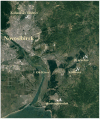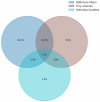Three-Year Monitoring of Microorganisms' Composition and Concentration in Atmospheric Aerosols of Novosibirsk City and Suburbs
- PMID: 39458377
- PMCID: PMC11509922
- DOI: 10.3390/microorganisms12102068
Three-Year Monitoring of Microorganisms' Composition and Concentration in Atmospheric Aerosols of Novosibirsk City and Suburbs
Abstract
The atmospheric environment is formed under the influence of local and distant sources as a result of horizontal and vertical transport. In the present work, microbiological analysis of 604 samples of atmospheric aerosol collected in the period from September 2020 to September 2023 at four sites differing in anthropogenic load, located in Novosibirsk and the region, was carried out. Day and night aerosol samples were collected during 12 h every two weeks by filtration using Sartorius reinforced Teflon membranes, then sown on a set of nutrient media. The taxonomic affiliation of the isolated microbial isolates was determined based on phenotypic characteristics and analysis of 16S rRNA gene nucleotide sequences. Changes in the composition and concentration of culturable microorganisms depending on the season, time of day, and site of aerosol sampling were observed. In winter, lower fungi and bacteria of the genera Bacillus, Staphylococcus, Micrococcus dominated with an average concentration from zero to 12.5 CFU/m3 of aerosol. In the warm period, the concentration and diversity of cocci, spore-forming and non-spore-forming bacteria, actinomycetes, and fungi (up to 1970 CFU/m3), among which pathogenic microorganisms were found, increased sharply in aerosols. The use of 16S metabarcoding techniques has greatly expanded the range of aerosols' microbial diversity detectable.
Keywords: 16S rRNA; Novosibirsk; atmospheric aerosol; biodiversity; concentration; metabarcoding; microorganisms; pathogenicity.
Conflict of interest statement
The authors declare no conflicts of interest.
Figures







Similar articles
-
Culturable bioaerosols along an urban waterfront are primarily associated with coarse particles.PeerJ. 2016 Dec 22;4:e2827. doi: 10.7717/peerj.2827. eCollection 2016. PeerJ. 2016. PMID: 28028485 Free PMC article.
-
[Concentration and Particle Size Distribution Characteristics of Microbial Aerosol and Bacterial Community Structure During Spring in Lanzhou City, China].Huan Jing Ke Xue. 2021 Apr 8;42(4):1668-1678. doi: 10.13227/j.hjkx.202006023. Huan Jing Ke Xue. 2021. PMID: 33742802 Chinese.
-
Assessment of microbiological aerosol concentration in selected healthcare facilities in southern Poland.Cent Eur J Public Health. 2019 Sep;27(3):239-244. doi: 10.21101/cejph.a5681. Cent Eur J Public Health. 2019. PMID: 31580561
-
Variability of airborne microflora in a hospital ward within a period of one year.Ann Agric Environ Med. 2006;13(1):99-106. Ann Agric Environ Med. 2006. PMID: 16841880
-
Bacterial and fungal aerosols in indoor environment in Central and Eastern European countries.Ann Agric Environ Med. 2002;9(1):17-23. Ann Agric Environ Med. 2002. PMID: 12088392 Review.
References
-
- On the State and Protection of the Novosibirsk Region Environment in 2022. Ministry of Natural Resources and Ecology of the Novosibirsk Region; Novosibirsk, Russia: 2023. (In Russian)
-
- Franchitti E., Caredda C., Anedda E., Traversi D. Urban aerobiome and effects on human health: A systematic review and missing evidence. Atmosphere. 2022;13:1148. doi: 10.3390/atmos13071148. - DOI
Grants and funding
LinkOut - more resources
Full Text Sources

